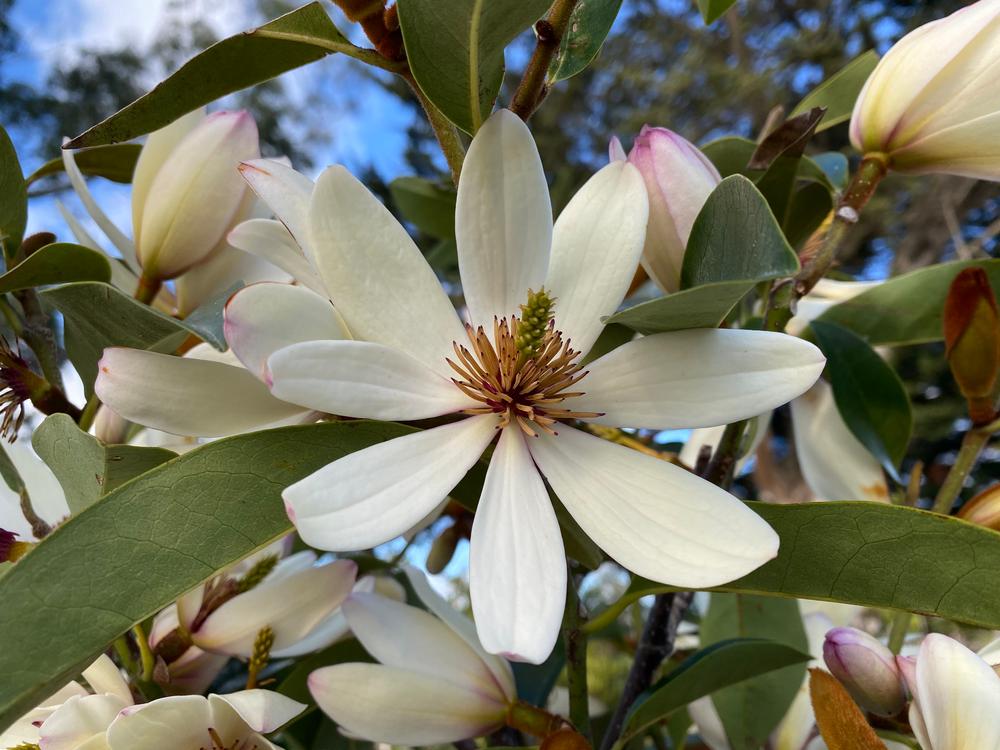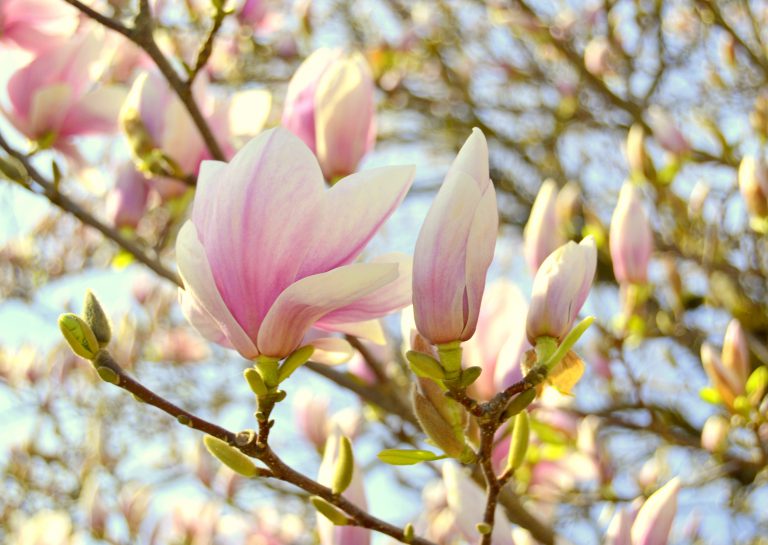The Timeless Allure of Magnolia: A History, Cultivation, and Appreciation

Magnolias, with their striking blooms and elegant foliage, have captivated humans for centuries. These ancient trees, predating even bees, stand as living testaments to the enduring power and beauty of the natural world. From the delicate simplicity of star magnolias to the opulent grandeur of Southern magnolias, this diverse genus offers something for every garden and admirer. This article delves into the fascinating history, cultivation, and appreciation of magnolias, exploring their botanical significance, cultural impact, and practical aspects of growing these magnificent trees.
A Glimpse into Antiquity: The Evolutionary Story of Magnolia
The history of magnolias stretches back an astonishing 100 million years, placing them among the earliest flowering plants on Earth. Fossil records reveal that magnolias flourished during the Cretaceous period, long before the evolution of bees. This pre-dates the evolution of bees, making the trees pollinated by beetles and other insects that crawled over them. Their sturdy, cup-shaped flowers were perfectly adapted for pollination by these early pollinators. This ancient lineage is evident in their primitive floral structure, lacking distinct petals and sepals, instead possessing tepals – undifferentiated floral segments.
The genus Magnolia is named after French botanist Pierre Magnol, a director of the Jardin Botanique de Montpellier in the late 17th and early 18th centuries. While Magnol himself did not discover or introduce any magnolias, his pioneering work in plant classification led Carl Linnaeus to honor him by naming this remarkable genus after him.
A Global Tapestry: Diversity and Distribution
Today, the Magnolia genus comprises over 200 species, distributed across diverse regions of the world. The majority of species are native to East and Southeast Asia, with a secondary center of diversity in the Americas, particularly in the southeastern United States and parts of Central and South America.
This wide distribution has resulted in a remarkable variety of magnolia forms. Some are deciduous, shedding their leaves in the fall, while others are evergreen, retaining their foliage year-round. They range in size from small, shrubby species to towering trees reaching heights of over 100 feet. Flower colors vary from pure white and creamy yellow to vibrant shades of pink, purple, and even deep red. Flower shapes are equally diverse, ranging from the delicate star-shaped blooms of Magnolia stellata to the large, saucer-shaped flowers of Magnolia x soulangeana.
Some notable magnolia species include:
- Southern Magnolia (Magnolia grandiflora): A majestic evergreen tree native to the southeastern United States, renowned for its large, fragrant white flowers and glossy, dark green leaves. It is a symbol of the American South.
- Saucer Magnolia (Magnolia x soulangeana): A popular deciduous hybrid prized for its large, cup-shaped flowers that bloom in early spring in shades of pink, purple, and white.
- Star Magnolia (Magnolia stellata): A small, deciduous shrub or tree known for its star-shaped, pure white flowers that appear in early spring.
- Lily Magnolia (Magnolia liliiflora): A deciduous shrub or small tree with upright, goblet-shaped flowers that are typically purple on the outside and white on the inside.
- Cucumber Tree (Magnolia acuminata): A large deciduous tree native to the eastern United States, known for its cucumber-shaped fruits and greenish-yellow flowers.
- Sweetbay Magnolia (Magnolia virginiana): A deciduous or semi-evergreen tree native to the eastern United States, with fragrant, creamy white flowers and silvery undersides to its leaves.


Cultivating Beauty: Planting and Caring for Magnolias
Growing magnolias can be a rewarding experience, but it’s essential to understand their specific needs to ensure their health and longevity.
- Location: Magnolias generally prefer a sunny location with well-drained soil. However, some species, such as Magnolia virginiana, can tolerate moist or even wet conditions. Protection from strong winds is also important, as the large flowers can be easily damaged. Consider the mature size of the tree when choosing a planting location, allowing ample space for it to grow.
- Soil: Magnolias thrive in slightly acidic soil that is rich in organic matter. Amend heavy clay soils with compost or other organic amendments to improve drainage and aeration. Avoid planting magnolias in alkaline soils, as this can lead to nutrient deficiencies.
- Planting: The best time to plant magnolias is in the spring or fall. Dig a hole that is twice as wide as the root ball and just as deep. Gently remove the tree from its container and loosen any circling roots. Place the tree in the hole, ensuring that the top of the root ball is level with the surrounding soil. Backfill the hole with soil and gently tamp it down. Water thoroughly after planting.
- Watering: Newly planted magnolias need regular watering to establish their root systems. Water deeply and regularly during the first growing season, especially during dry periods. Once established, magnolias are relatively drought-tolerant, but they will benefit from occasional watering during prolonged dry spells.
- Fertilizing: Magnolias benefit from regular fertilization, especially during the spring growing season. Use a fertilizer formulated for acid-loving plants, such as azaleas or rhododendrons. Follow the manufacturer’s instructions for application rates.
- Pruning: Magnolias generally require minimal pruning. Remove any dead, damaged, or crossing branches in late winter or early spring. Avoid heavy pruning, as this can damage the tree and reduce flowering.
- Pests and Diseases: Magnolias are generally resistant to pests and diseases. However, they can occasionally be affected by scale, aphids, or spider mites. These pests can be controlled with horticultural oil or insecticidal soap. Magnolias can also be susceptible to fungal diseases, such as leaf spot or canker. These diseases can be prevented by ensuring good air circulation and avoiding overhead watering.

Magnolias in Culture and Art: A Symbol of Beauty and Resilience
Throughout history, magnolias have held significant cultural and symbolic value. In China, magnolias are associated with purity, nobility, and femininity. They are often depicted in Chinese art and literature as symbols of beauty and grace. In the southern United States, the Southern magnolia is a symbol of the region’s rich history and culture. Its large, fragrant flowers are often used in weddings and other special occasions.
Magnolias have also inspired countless artists, writers, and musicians. Their beauty and elegance have been captured in paintings, sculptures, poems, and songs. The magnolia’s enduring appeal lies in its timeless beauty and its ability to evoke a sense of peace and tranquility.
The Future of Magnolias: Conservation and Hybridization
As with many plant species, magnolias face threats from habitat loss and climate change. Conservation efforts are underway to protect magnolia populations in their native habitats. Botanical gardens and arboretums around the world are also playing a vital role in preserving magnolia diversity by maintaining collections of different species and cultivars.
Hybridization, the process of crossing two different magnolia species, has led to the development of many new and exciting cultivars. Hybridizers are working to create magnolias with improved flower color, shape, and fragrance, as well as increased disease resistance and cold hardiness. These efforts are ensuring that magnolias will continue to thrive and delight gardeners for generations to come.
FAQ About Magnolias
- Are magnolias easy to grow? Generally, yes, but they require the right conditions: well-drained, slightly acidic soil and plenty of sunlight.
- When do magnolias bloom? Bloom times vary depending on the species and cultivar. Some bloom in early spring, while others bloom in summer.
- How big do magnolias get? Size varies greatly depending on the species. Some are small shrubs, while others are large trees.
- Can I grow magnolias in containers? Yes, but you’ll need to choose a smaller species or cultivar and provide adequate drainage and nutrients.
- Why isn’t my magnolia blooming? Several factors can affect blooming, including lack of sunlight, poor soil, improper pruning, or late frosts.
- Are magnolia flowers edible? Some parts of some magnolia species are edible, often pickled or used as a spice. However, it’s essential to research the specific species and ensure it is safe for consumption. Avoid eating flowers from ornamental magnolias without verifying their edibility.
- Do magnolias attract wildlife? Magnolias can attract pollinators like beetles and some birds. Their seeds also provide food for some wildlife.
Conclusion: An Enduring Legacy
Magnolias, with their ancient lineage and breathtaking beauty, are more than just ornamental trees. They are living links to the past, symbols of resilience, and sources of inspiration. Whether you admire them in a botanical garden, cultivate them in your own backyard, or simply appreciate their presence in the landscape, magnolias offer a unique and profound connection to the natural world. By understanding their history, cultivation requirements, and cultural significance, we can ensure that these magnificent trees continue to thrive and enrich our lives for generations to come. Their timeless allure continues to captivate, reminding us of the enduring power and beauty of the natural world.
